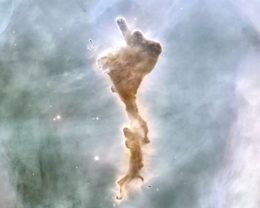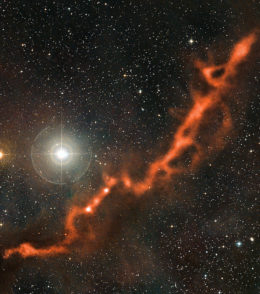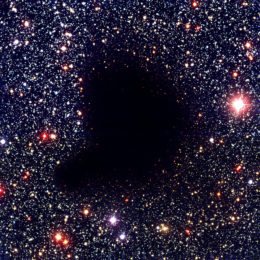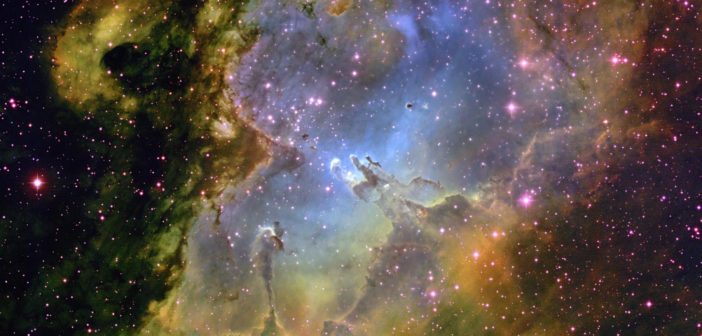Molecular clouds — which you’re likely familiar with from stunning popular astronomy imagery — lead complicated, tumultuous lives. A recent study has now found that these features must be rapidly built and destroyed.
Star-Forming Collapse

A Hubble view of a molecular cloud, roughly two light-years long, that has broken off of the Carina Nebula. [NASA/ESA, N. Smith (University of California, Berkeley)/The Hubble Heritage Team (STScI/AURA)]
How does this collapse occur? The simplest explanation is that the clouds simply collapse in free fall, with no source of support to counter their contraction. But if all the molecular gas we observe collapsed on free-fall timescales, star formation in our galaxy would churn a rate that’s at least an order of magnitude higher than the observed 1–2 solar masses per year in the Milky Way.
Destruction by Feedback
Astronomers have theorized that there may be some mechanism that supports these clouds against gravity, slowing their collapse. But both theoretical studies and observations of the clouds have ruled out most of these potential mechanisms, and mounting evidence supports the original interpretation that molecular clouds are simply gravitationally collapsing.

A sub-mm image from ESO’s APEX telescope of part of the Taurus molecular cloud, roughly ten light-years long, superimposed on a visible-light image of the region. [ESO/APEX (MPIfR/ESO/OSO)/A. Hacar et al./Digitized Sky Survey 2. Acknowledgment: Davide De Martin]
Speedy Building?
In a recent study, a team of scientists led by Mordecai-Mark Mac Low (American Museum of Natural History and Heidelberg University, Germany) explore whether there is a way to create molecular clouds rapidly enough to match the necessary rate of destruction.
Mac Low and collaborators find that some common mechanisms used to explain the formation of molecular clouds — like gas being swept up by supernovae — can’t quite operate quickly enough to combat the rate of cloud destruction. On the other hand, the Toomre gravitational instability, which is a large-scale gravitational instability that occurs in gas disks, can very rapidly assemble gas into clumps dense enough to form molecules.

A composite of visible and near-infrared images from the VLT ANTU telescope of the Barnard 68 molecular cloud, roughly half a light-year in diameter. [ESO]
A Rapid Cycle
Based on their findings, the authors argue that dense, star-forming molecular clouds persist only for a short time before collapsing into stars and then being blown apart by stellar feedback — but these very clouds are built equally quickly via gravitational instabilities.
Conveniently, this model has a very testable prediction: the Toomre instability is expected to become even stronger at higher redshift, which suggests that the fraction of gas in the form of molecules should increase at high redshifts. This appears to agree with observations, supporting the authors’ picture of a rapid cycle of cloud assembly and destruction.
Citation
Mordecai-Mark Mac Low et al 2017 ApJL 847 L10. doi:10.3847/2041-8213/aa8a61


2 Comments
Pingback: Molecular clouds: make, break
Pingback: El criterio de Toomre y la tasa de formación estelar. | Pablo Della Paolera